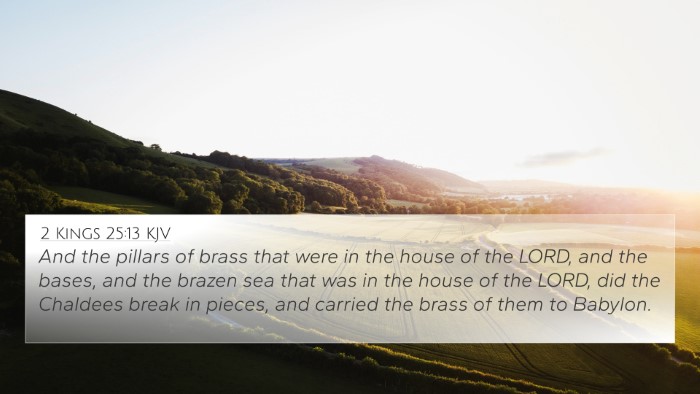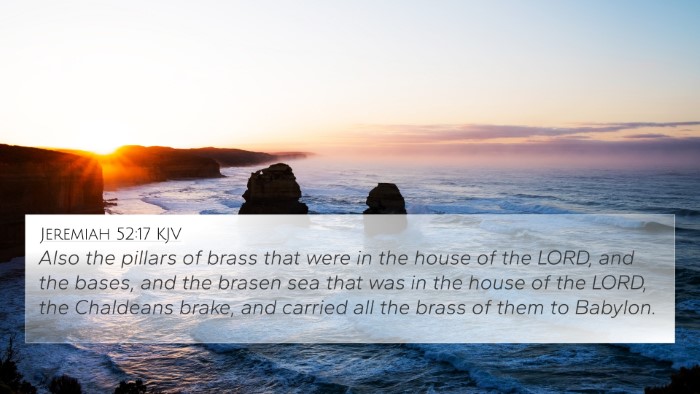Understanding 2 Chronicles 36:18
Verse: “And all the vessels of the house of God, great and small, and the treasures of the house of the Lord, and the treasures of the king, and of his princes, all these he brought to Babylon.”
Summary of the Verse
This verse highlights a pivotal moment in Israel’s history when the Babylonian king Nebuchadnezzar took the sacred items from the temple in Jerusalem, signaling a period of exile and judgment for the nation of Judah. This action not only symbolizes the loss of divine favor but also serves as a precursor to the challenges the Israelites would face during the Babylonian captivity.
Commentary Insights
Insights from prominent biblical commentaries provide a richer understanding of this verse:
Matthew Henry's Commentary
Matthew Henry emphasizes that this verse reflects the culmination of Judah’s disobedience and the resultant consequences. He notes that the treasures taken were not only material possessions but also represented the glory of God’s presence among His people. Henry stresses the importance of these vessels, as they were intended for the service of God and their removal indicates a severe spiritual depravity.
Albert Barnes' Notes
Albert Barnes points out that this event is significant in the historical narrative, as it signifies the transition of power and the validation of prophetic warnings. He relates it to God's sovereignty over nations, demonstrating that even the mightiest human powers are tools in the divine plan. Barnes also relates to the idea that the Babylonian invasion was a direct fulfillment of the prophecies foretelling judgment against Israel’s persistent idolatry.
Adam Clarke's Commentary
Adam Clarke provides a detailed analysis of the itemization of the treasures taken. He indicates that the “great and small” vessels encompass all elements of worship, thereby addressing the totality of the desecration suffered by Israel. Clarke highlights the implications this had for the Israelites, signaling not only the physical destruction but a spiritual void, leading them to contemplate their covenant relationship with God.
Bible Cross-References
To fully appreciate the implications of 2 Chronicles 36:18, one can explore various cross-references that parallel this narrative:
- 2 Kings 24:13: Highlights the same event where Nebuchadnezzar carries off the treasures.
- Jeremiah 52:17-23: Provides additional details on the plundered items and their significance.
- Isaiah 39:6: Prophesies that the treasures will be carried off to Babylon.
- Daniel 1:2: Notes the carrying away of sacred items as part of the conquest.
- Psalm 137:7: Reflects on the Israelites’ sorrow regarding the captors’ desecration of their temple.
- Lamentations 1:10: Discusses the consequences of the siege and the loss of sacred vessels.
- Exodus 20:5: Reminds that God's jealousy extends to consequences for disobedience.
- Daniel 5:2-4: Connects to the later usage of these vessels in Babylonian feasts.
- Haggai 2:8: Indicates that God claims the silver and gold, emphasizing ownership over sacred items.
- Revelation 21:22: Symbolizes the restoration of God’s presence among His people and the ultimate purpose of vessels.
Thematic Connections
This passage and its cross-references allow for numerous thematic connections within Scripture, including:
- Judgment and Restoration: The themes of God’s judgment against His people due to idolatry and His eventual plan for restoration.
- Sacredness of Worship: The significance of the items taken from the temple in maintaining God’s worship.
- The Sovereignty of God: A recurring theme expressed throughout Scriptures illustrating God’s control over human affairs and history.
- Consequences of Disobedience: A consistent biblical principle that underscores the results of turning away from God.
- Hope and Repentance: Biblical narrative always points toward hope, urging repentance and return to God even after judgment.
Tools for Bible Cross-Referencing
For those studying the connections between Bible verses, several tools can enhance understanding:
- Bible Concordance: Helps in finding specific verses and their related contexts.
- Bible Cross-Reference Guide: Provides a structured way to study related scripture passages.
- Cross-Reference Bible Study: Encourages deeper engagement with the text through thematic analysis.
- Bible Reference Resources: Compile comprehensive materials for in-depth scriptural study.
- Bible Chain References: Follow thematic chains across various texts.
Interpreting Biblical Themes through Cross-References
When attempting to understand the fuller meaning of 2 Chronicles 36:18, it is beneficial to approach it with the following questions:
- What other verses are highlighted in relation to this passage?
- How do the prophecies correspond with historical accounts concerning these events?
- What lessons can be drawn from this verse in the context of God’s covenant with His people?
- In what ways do these scriptures illustrate God’s ongoing relationship with Israel?
- How does this verse inform us about the significance of sacred objects in the context of worship?
Conclusion
In summary, 2 Chronicles 36:18 serves as a pivotal verse illustrating the downfall of Judah and the profound implications of their choices. Through the insights of various biblical scholars and the connections to other scripture passages, we gain a greater understanding of the themes of judgment, sacredness, and hope woven throughout the biblical narrative. Engaging with Bible cross-references allows for a richer study experience, highlighting how interconnected God’s word truly is in unveiling His plan for redemption and restoration.











